WANT TO LEARN MORE ABOUT THE ROTATION? DON’T KNOW HOW TO MAXIMIZE YOUR DUST GAIN? CHECK OUT OUR ROTATION GUIDE!
The Year of the Dragon Hall of Fame class was unexpected and is bound to shape the Hearthstone Standard format meta more than any previous Hall of Fame rotation – mostly because the key Legendary cards from The Witchwood expansion, Genn Greymane and Baku the Mooneater, will go on an early retirement alongside all of the Even and Odd support cards.
Furthermore, three solid Classic set cards are on their way to Hall of Fame: Doomguard, Naturalize, and Divine Favor.
In this article, we’ll examine the current use of these cards and how their rotation out of Standard format affects the decks they are used in.
Doomguard
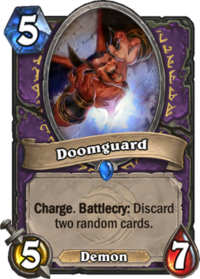
Doomguard has been a Warlock staple throughout the years. It is immensely powerful, a 5/7 minion with Charge for mere five mana, but the added cost of discarding two cards is a hefty price to pay. It is nonetheless a price many players have been willing to pay, making it one of the only Discard mechanic cards that have been strong enough to see play without synergy support: the only other ones being Soulfire, Deathwing, and Cataclysm (only in Mecha'thun combo decks).
The current era is not the most dominant era of Doomguard, though. In fact, it is quite the opposite. Doomguard has been a Zoo Warlock staple, but most current Zoo builds opt to go for Leeroy Jenkins and two Despicable Dreadlords, skipping Doomguard entirely. If anything, the rotation hurts budget Zoo players, for whom Doomguard is the most direct replacement for the expensive Legendary Leeroy Jenkins.
Doomguard is obviously present in Cube Warlock, which is still a dominant force, but Cube Warlock will die in the Standard rotation: Skull of the Man'ari, Possessed Lackey, Carnivorous Cube, and Bloodreaver Gul'dan are all rotating out, so the deck has no means left to summon and multiply Doomguards anyway. Rotating Doomguard to Hall of Fame does nothing compared to all those losses.
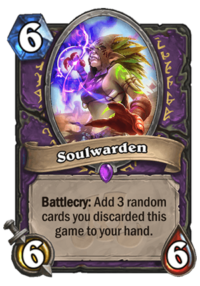
The main casualty of the Doomguard rotation may in fact be Warlock decks that want to make use of the Discard mechanic. It is already difficult to find Discard cards that are good enough to play, and a midrange style with Doomguard and Soulwarden has been somewhat viable. Soulwarden is one of the most prominent current Warlock cards to build around after the rotation – which is set to hit Warlock hard – but without Doomguard, it is hard to see what the right synergy cards could be.
Overall, the rotation of Doomguard is hitting a class that is already set to struggle after the Standard rotation, taking away both one of the best budget cards and one of the key synergy pieces from a potential post-rotation Warlock archetype. Hopefully, the next expansion will give Warlock suitable substitutes, but history does not support this hope: Blade Flurry nerf, for example, was only truly justified by the introduction of Kingsbane three expansions later. Of course, Blizzard has had ample time to learn from that era, so maybe this time the reasons will become apparent faster.
Naturalize
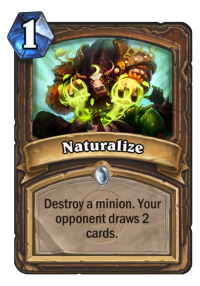
Naturalize was the problem all along? If you were to tell that to Hearthstone players from the past, they would wonder why, because the card has been hardly playable most of the time. It is a powerful card, but it has a significant drawback attached to it, although one that can be turned into an advantage with specific choices or in specific decks.
Naturalize is a piece of hard removal for Druid, but so was Mulch: Druid’s main issue used to be dealing with wide boards, not with individual big minions. Spreading Plague changed that, and for a time Druid was able to deal with a wide variety of threats, but this is already changing in the rotation with Spreading Plague and Lesser Jasper Spellstone on their way out of Standard.
Currently, Naturalize plays a key role in various King Togwaggle decks, whether with Hakkar, the Soulflayer or with Azalina Soulthief. However, King Togwaggle is rotating out of Standard anyway, so all of those decks are dead no matter what happens with Naturalize.
Naturalize has also been a key piece in every attempt to build Mill Druid already before King Togwaggle, but those hopes have been buried ever since Coldlight Oracle was rotated out of Standard. Perhaps the new expansion will include some mill support, and Naturalize would have been too scary with that, but that is unlikely given how little support mill has had in Hearthstone over the years as an archetype.
There is one deck that will be directly killed by the Naturalize rotation: Mecha’thun Druid. The deck already faced an uncertain future, because the rotation of Barkskin and Earthen Scales will remove its ability to do big Wild Pyromancer clears, but it had its main combo intact: Mecha'thun + Innervate + Naturalize. Now, it will have no tools to kill Mecha'thun, and can therefore not pull off its combo anymore.
How much the lack of Naturalize will hurt any other combo or control Druid decks remains to be seen. It depends on the overall removal package available to Druid and how important single-target hard removal will be in the upcoming meta.
Divine Favor
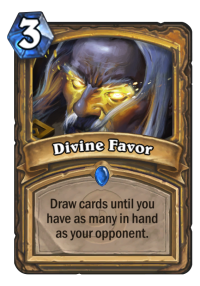
Divine Favor is a scary card draw tool that has powered Aggro Paladins through the ages. It is meta-dependent though, as it can make life extremely difficult for control decks, but is almost completely dead in aggro matchups where the opponent is not holding on to many cards anyway.
In the current meta, the deck that relies on Divine Favor the most is Secret Paladin. Turns out that when you put in a whole bunch of one-mana cards into your deck, having the ability to draw more cards comes in handy. The future of Secret Paladin was uncertain already before the Hall of Fame announcement, and now things look even more dire for the archetype. It gets to keep Bellringer Sentry and Secretkeeper, but a large part of the deck is rotating, so it needed a big rebuild, and more losses make that rebuild even harder.
Odd Paladin makes use of Divine Favor as well, but in that deck it is more of a tech card. Some builds opt to go for Witch's Cauldron instead, so this rotation is not what kills Odd Paladin. The rotation of Baku the Mooneater, however, certainly will.
Overall, Aggro Paladin decks will struggle for resources a lot more without Divine Favor, and this loss may lead to Midrange Paladin looking like a more attractive option.
Genn Greymane
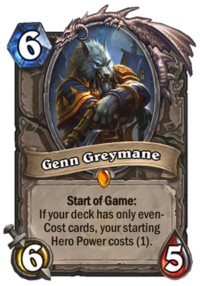
Genn Greymane was all set to dominate the next year of Hearthstone together with Baku the Mooneater, but their strength was too much for Blizzard, and both are being sent off to early retirement alongside all of their support cards, in Genn’s case Murkspark Eel.
This move will kill all the Even decks, and there are quite a few in the meta:
- Even Paladin is considered to be one of the best decks in the game and was expected to have a great future ahead.
- Even Shaman has been the strongest Shaman archetype, even after the Flametongue Totem nerf.
- Even Warlock is a popular tournament deck and a viable ladder deck with the right tech choices. It was likely going to die with the rotation anyway though.
- Even Rogue is a challenger that is quite off-meta at the moment, but that could have had a lot of potential after the rotation.
Even decks have been the strongest midrange decks for several classes. With that synergy gone, new space may open up for different midrange archetypes to succeed.
For Paladin, there is The Glass Knight, Spirit of the Tiger, and various Mech synergies, all of which have more room to breathe without Even and Odd synergies ruling the world.
For Shaman, there is Hagatha the Witch and Shudderwock, so it may be possible to rebuild something with a lot of value-generation along the lines of the current Elemental Shaman.
For Warlock, things look grim, but at least there is always Zoo. Yeah, it’s not quite the same thing as Even Warlock, but it’s something.
Baku the Mooneater
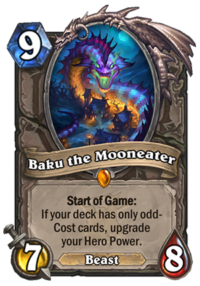
Baku the Mooneater is even more dominant than Genn Greymane, providing a more aggressive alternative to Genn’s midrange approach. All of the Odd support cards – Black Cat, Glitter Moth, and Gloom Stag – will rotate to Hall of Fame together with Baku, but this is mostly free dust for players, as those cards are useless without Baku anyway.
There are lots of Odd decks in the meta at the moment:
- Odd Paladin is one of the best decks in the game, and even though it loses a lot in the rotation, it was likely to survive because of the pure strength of its Hero Power.
- Odd Rogue survived the Cold Blood nerf and still represents the premium level of aggro in the game.
- Odd Warrior is the epitome of fatigue-style control in the meta, and looked likely to survive the rotation (Odd Quest Warrior would have died anyway without the quest).
- Secret Odd Mage is a powerful aggro deck and was one of the most likely ones to survive the rotation (the control variant would probably die anyway without Frost Lich Jaina).
- Odd Hunter is the current manifestation of Face Hunter, and was destined to carry the mantle on to Year of the Dragon.
From the most aggressive of decks to the most defensive of decks, the influence of Baku the Mooneater has been felt everywhere. What is even going to happen when all of this goes away? Warriors cannot tank up all game anymore? Board cannot be flooded with endless tokens anymore? What?
Aggressive Paladin decks may struggle with both Baku the Mooneater and Divine Favor rotating out, but perhaps secret synergies will still prove to be enough.
Rogue always finds a way. No matter how weird or useless the Legendaries printed for the class turn out to be, there is always some trick up Valeera’s sleeve that makes the class survive.
Warrior will need to figure out survivability without tanking up and also without Drywhisker Armorer, and Control Mage will need to completely reinvent itself in a world without Frost Lich Jaina and Arcane Artificer. The future of control is completely open.
Secret Odd Mage can probably be replaced with some kind of a regular tempo build. The players hurt the most will be the ones who invested in Jan'alai, the Dragonhawk, which is going to be miles weaker without that upgraded Hero Power to fuel it, and there is no refund coming.
Face Hunter has phased in and out of the meta, and while it looked like a promising post-rotation archetype in its Odd form, it might not be part of the next meta without that improved Hero Power.
Conclusions
The upcoming Standard rotation was already going to be a big one: the expansions from 2017 are considerably stronger than those from 2018, and the power level in the game was going to go down by a fair amount. Now, the most powerful cards from 2018 are also rotating out, so the field will be blown wide open.
Will the 2019 meta consist of Rush Warriors, Pirate Rogues, and Mech Paladins? At this point, anything is possible. It is going to be one exciting rotation!

R.I.P Jan’alai
R.I.P. My 1600 Dust
“The players hurt the most will be the ones who invested in Jan’alai, the Dragonhawk” – arg, yes! Maybe they will print some kind of replacement, otherwise I see mage struggling against the likes of Hagatha/Boom/Zul’jin…
Yeah, there’d be little reason to ever play Jan’alai without Daring Fire Eaters to compensate.